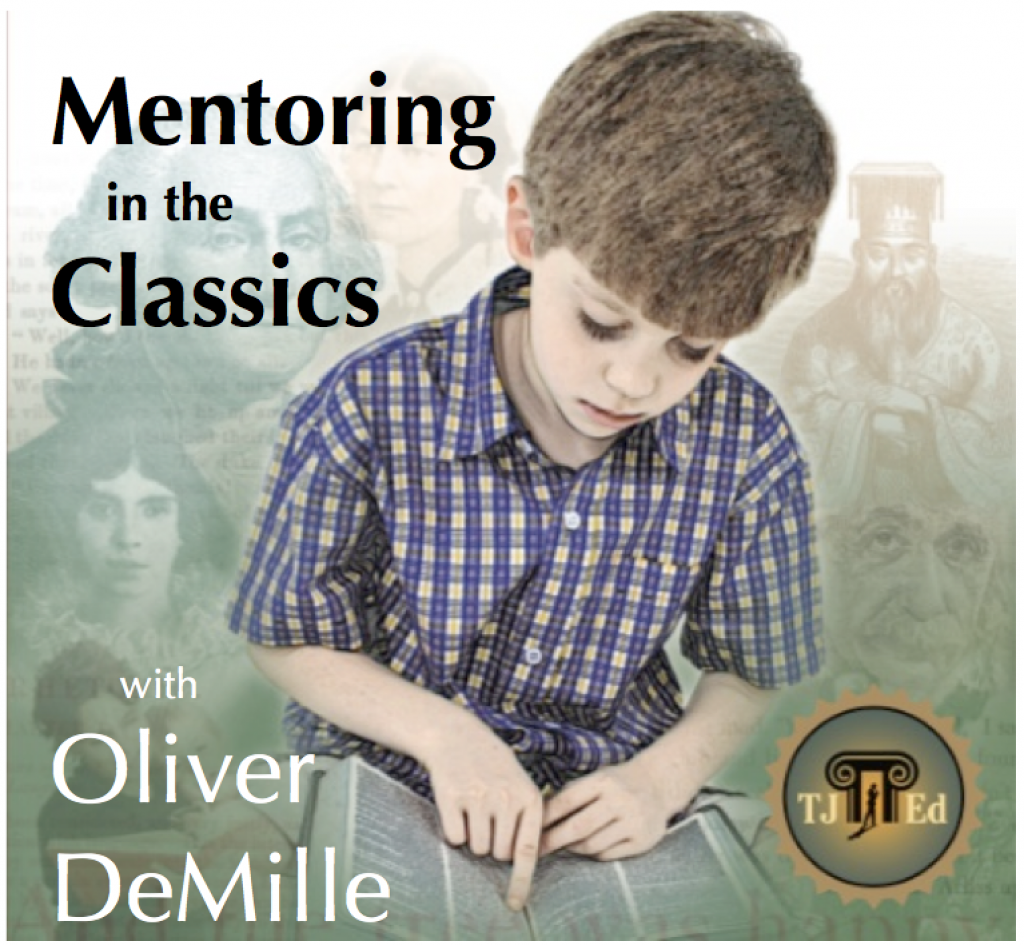What Every Parent (and Citizen and Leader) Should Know Right Now About College
August 1st, 2025 // 9:16 am @ Oliver DeMille
 I’ll be brief. College is changing rapidly, and parents, leaders and anyone who cares about education, freedom and our society needs to know about and understand these changes. Specifically, they need to know about 7 significant changes that are happening right now in the college-university-credential-career system. These are dramatically impacting our nation. Yet for some reason these changes are not effectively making it into the hands of all, or even most, parents, students and others who care about our society.
I’ll be brief. College is changing rapidly, and parents, leaders and anyone who cares about education, freedom and our society needs to know about and understand these changes. Specifically, they need to know about 7 significant changes that are happening right now in the college-university-credential-career system. These are dramatically impacting our nation. Yet for some reason these changes are not effectively making it into the hands of all, or even most, parents, students and others who care about our society.
Let’s change that, right here. The purpose of this post isn’t to promote college, or to discourage it. For some young adults, college is the perfect thing, and others may thrive more in an alternative to college. But without a knowledge of these changes, nobody is fully informed and therefore it can be much more difficult to make the best decisions for each individual student—or for citizens to understand how these changes are impacting our national future.
1. Changing Views on College
 A lot of people, including many higher education experts, are questioning if college is worth the cost anymore. According to Gallup, high confidence in college and universities is down to just 36 percent, after being much higher for the last five decades. (“American’s Confidence in Higher Education Remains at All-Time Low” The Epoch Times, Pan)
A lot of people, including many higher education experts, are questioning if college is worth the cost anymore. According to Gallup, high confidence in college and universities is down to just 36 percent, after being much higher for the last five decades. (“American’s Confidence in Higher Education Remains at All-Time Low” The Epoch Times, Pan)
For those planning on careers in licensed fields such as medicine, law, public-school teaching, etc., college is necessary. For many careers it is not. The key is to research the options and personalize for your
2. Rising Costs and The Six-Year Degree
The price tag of a college education has skyrocketed. The annual cost of tuition has increased more than 179 percent in the last 20 years (“How are college costs adding up these days and how much has tuition risen?” USA Today, Chernikoff; “Buyer Beware: Fees Skyrocket Costs of Higher Education” Forbes, Ladany), and the cost of housing and other living expenses went up almost twice as fast as tuition rose during this time.
The average annual cost of attending an in-state 4-year public college increased from $3,500 per year in 2001 to $9,750 in 2022 (Education Data Initiative, EducationData.org, Hanson). This does not include the higher room and board prices (now averaging $12,917 a year), higher costs for books and supplies (now $1,220 per year), and almost $4,100 per year in additional expenses for students not living at home. (Ibid.)
 In addition to these increases, the average time to graduate with an undergraduate degree is now 6 years, not the traditional 4 years of decades ago. (National Center for Education Statistics) With all these expenses added together, the average total cost for a person to get a public undergraduate degree is estimated at between $168,000 and quite a bit higher.
In addition to these increases, the average time to graduate with an undergraduate degree is now 6 years, not the traditional 4 years of decades ago. (National Center for Education Statistics) With all these expenses added together, the average total cost for a person to get a public undergraduate degree is estimated at between $168,000 and quite a bit higher.
In comparison, though there are differing statistics on this, the approximate total cost for an undergraduate degree twenty years ago was around $58,000. Note that these numbers are for public institutions; most traditional private schools cost a lot more. None of these numbers include the cost of interest on student loans. The numbers of young college graduates filing for bankruptcy recently hit the all-time high. (“Is College Education No Longer Worth It?” The Epoch Times, Ford)
College can be a long-term boost to the finances of graduates; but this is not guaranteed, though many people assume it is. Financial returns over a lifetime based on college degrees depend a great deal on the student’s college major and first job after graduation. Over 52 percent of recent college graduates are underemployed, meaning they work in a job that doesn’t require a college degree. (“Most college graduates face underemployment upon bachelor’s attainment,” The Thomas B. Fordham Institute, Murray) Just over a quarter of graduates in some majors end up working in their field. In the STEMM (Science, Technology, Engineering, Mathematics, and Medicine) majors and other licensed fields this number is typically much higher. The 6 year average time to get an undergraduate degree is a major change from the 4 year model of past decades.
3. The Real Numbers and the Skilled Careers
 Many parents and grandparents are wondering: What is college even like now, compared to when they attended? The old myths about college graduates receiving a million dollars more in lifetime earnings than non-college peers have been debunked, because too many factors weren’t included in that statistic, like the added costs of student loans and interest, the 4-7 fewer years those with degrees spend out of the work force, the extra savings and investing the non-college person makes for 4-7 extra years, the significant differences in lifetime earnings between different academic majors—and between males and females, and other demographic groups—etc.
Many parents and grandparents are wondering: What is college even like now, compared to when they attended? The old myths about college graduates receiving a million dollars more in lifetime earnings than non-college peers have been debunked, because too many factors weren’t included in that statistic, like the added costs of student loans and interest, the 4-7 fewer years those with degrees spend out of the work force, the extra savings and investing the non-college person makes for 4-7 extra years, the significant differences in lifetime earnings between different academic majors—and between males and females, and other demographic groups—etc.
In certain majors, college graduates still make a lot more than non-credentialed workers, but in many majors they don’t. And demographic trends are greatly increasing the demand for many non-college skilled trades and careers (e.g. construction managers, electricians, plumbers, business owners, dental hygienists, various types of therapists, technicians, and high-tech roles, etc.), a number of which are increasingly more lucrative than college degrees in many majors.
For example, consider the “Doctor vs. Plumber Debates” about which career path is wealthier at age 42. There are lots of articles and videos on this. Surprising and interesting. A little folksy at times, but important information.
4. Fewer Students and Cutting Programs
Because of population trends, starting in the fall semester of 2025 and for many years ahead the number of college-age students will be significantly smaller than it has been up to now (“A looming ‘demographic cliff’: Fewer college students and ultimately fewer graduates” NPR, Marcus), meaning major economic downturns in higher education. Decreasing enrollments have led hundreds of campuses to close recently, and this trend is accelerating.
 With the added reality of a lot more college-age students opting for non-college alternatives, even most large prestigious schools are cutting faculty, staff, majors and various programs—or planning to make significant cuts in the years ahead.
With the added reality of a lot more college-age students opting for non-college alternatives, even most large prestigious schools are cutting faculty, staff, majors and various programs—or planning to make significant cuts in the years ahead.
Parents and students must do their research before enrolling to make sure the programs you’re seeking will still be there in 5-7 years when most of this year’s new freshman will graduate and the number of students in college will be significantly decreased.
5. A Lot More Alternatives
There are numerous popular and increasingly accepted alternatives to on-campus college education, including multiple new forms and styles of learning, job and career training.
 For example:
For example:
- gap year projects
- apprenticeships
- internships
- certifications from high-tech online training programs—many of them 1 year to 18 months in duration rather than 4-7 years
- online certificate programs
- bootcamp learning
- community colleges
- tech schools
- online college course options like those offered by Coursera, EdX, Udemy, Khan Academy, Udacity and many others
- great college-level programs that emphasize learning and ignore credits and grades—like non-credit classes from Harvard, Yale, MIT, Standford, Hillsdale, and hundreds of other colleges and universities
- high-quality educational organizations that aren’t colleges or universities such as The Great Courses, MasterClass, TedX, SkillShare, HubSpot Academy
And of course, my favorite: TJEd Depth.
Also, the movement by certain billionaires and other educational leaders to help some of the best and brightest young adults skip college and build a business, partner on an entrepreneurial venture, or join a start-up team. Simultaneously, the alternative credentials (not degrees) sector is growing rapidly, and alternative non-college credentials are now accepted by many big organizations, including IBM, Google, Bank of America, Apple, Amazon, the U.S. Federal Government, a growing number of U.S. state governments, and many more. (“How Alternative Credentials are Shaping Modern Education,” Higher Education Today; “Organizations that Accept Alternative Credentials in Hiring,” Google AI Overview; “The Rise of Alternative Credentials in Hiring,” SHRM.org)
Many experts and organizations now promote new “post-industrial-age” credentialing systems not based on degrees but rather on proven competencies, knowledge, experience and skills. This trend is increasingly known as the “skills first” model.
6. Woke-ism and the Shadow Curriculum
 Left-leaning political activism on most campuses is real and deeply concerning. The number of young adults from homes with traditional family values, pro-faith beliefs, and/or conservative views who are now adopting leftist, anti-family, anti-morality and/or anti-faith perspectives and even aggressively going “woke” during their college years is alarming.
Left-leaning political activism on most campuses is real and deeply concerning. The number of young adults from homes with traditional family values, pro-faith beliefs, and/or conservative views who are now adopting leftist, anti-family, anti-morality and/or anti-faith perspectives and even aggressively going “woke” during their college years is alarming.
A number of experts are concerned that a major focus of many colleges and universities in recent years seems to have shifted to things happening outside the classroom: protests, political arguments, shouting down visiting speakers (on campus but also in classes), mass walk-outs from classes and assemblies, protestors physically stopping students from going to classes, assaults based on political or religious views, etc.
It is important to look into the schools you’re considering and find out what kinds of things go on there.
7. Direct Admission Options
Because of demographic trends and declining enrollments, a number of colleges and universities have adopted or ramped up direct admission policies. (“Even if They Didn’t Apply, Some Students Get College Admission Offers” The New York Times, Carrns)
 Direct Admission means that a school accepts any student who meets certain criteria, such as a qualifying SAT or ACT score or a certain GPA, or other criteria—depending on the school. Qualifying students are guaranteed admission, and simply need to sign up, provide information the school can verify, and enroll.
Direct Admission means that a school accepts any student who meets certain criteria, such as a qualifying SAT or ACT score or a certain GPA, or other criteria—depending on the school. Qualifying students are guaranteed admission, and simply need to sign up, provide information the school can verify, and enroll.
This is streamlining the process for many students, and significantly decreasing the time and effort of getting into certain schools. It also cuts costs for the institution.
Over a hundred schools now offer direct admissions, including many state-run schools in over a dozen states (including Illinois, California, Texas, Minnesota, Idaho, Indiana, Washington, Hawaii, Utah, North Dakota, Wisconsin, Connecticut, Oregon and New York.) (“More state colleges are admitting students—before they apply” The Washington Post, Humphreys and Rizzolo) The number of direct admission schools is rapidly increasing.
One other thing that’s been around a long time, but is now increasingly prevalent, is online classes for credit that allow students to do much of their classwork from home or remote locations. In many schools these classes supplement in-class work, and in a growing number of schools the online coursework is the bulk of learning and in-class studies supplement the laptop or tablet learning.
In short: we’re living in an era of educational renaissance.
But all this change and these many new offerings have understandably sparked a lot of confusion about which of these alternatives work and which don’t. And which is best for a specific 18- to 24-year-old. Or older. Part of the challenge is that we don’t yet know which options will last and which will fade over time. And parents and students still must decide whether their main educational goals emphasize great learning or specific job credentialing.
 One more thought, which shocked me when I read about it in the excellent book, The Great Upheaval. Traditional on campus students aged 18-22 now account for less than 20 percent of college students. This number doesn’t even include students in the many non-college alternatives out there—it’s just about college students.
One more thought, which shocked me when I read about it in the excellent book, The Great Upheaval. Traditional on campus students aged 18-22 now account for less than 20 percent of college students. This number doesn’t even include students in the many non-college alternatives out there—it’s just about college students.
Another way to see this: More than 80 percent of actual college students are now non-traditional students, such as those in their 30s or older and those in distance studies on laptops at home or elsewhere rather than sitting in classrooms. Over 80 percent! Lots of changes. So many options. And more coming.
After all this, I’m left with two big questions:
1. What do we really want to happen with our current college/credentials/career system?
 The old system is struggling, mainly because industrial-age institutions are finding it very difficult to transition to the quantum age. But the old system also has some excellent features that have lasted for many decades. (I would say “centuries”, but the college system before 1944 was totally different than the system after 1944.) Most importantly, in terms of where we’re headed, a growing number of employers don’t trust the old 1944-2024 system. They want something new, something that fits today’s economy and needs. In other words, we’re going to get something new.
The old system is struggling, mainly because industrial-age institutions are finding it very difficult to transition to the quantum age. But the old system also has some excellent features that have lasted for many decades. (I would say “centuries”, but the college system before 1944 was totally different than the system after 1944.) Most importantly, in terms of where we’re headed, a growing number of employers don’t trust the old 1944-2024 system. They want something new, something that fits today’s economy and needs. In other words, we’re going to get something new.
Still, a lot of people don’t yet see the alternative credentials or learning systems as realistic replacements for the old college model. At the same time, student debt and young college graduate bankruptcies keep climbing; degrees in many majors simply aren’t delivering the “promised” financial returns. What is the best approach—for our children, the employers and the economy, the future of education and jobs, and the world?
- A: Would a return to the old-style system of colleges in the 1980s and 1990s—without all the confusing alternatives—be the best solution? One system, one standard of credentials?
- B: Would it be better to keep the old college-on-campus model for whoever wants it and simultaneously encourage new alternatives far and wide?
- C: Or would our best approach as a nation be to just dump the old and move on to the new—since it’s coming anyway, inevitably?
Your thoughts on this?
2. How bad would a major shift from the old college model to a new skills-based (non-degree-based) system hurt our nation?
 In my view, it might really help. For the past eight decades our colleges and universities have become less and less institutions of higher learning and more and more career training programs.
In my view, it might really help. For the past eight decades our colleges and universities have become less and less institutions of higher learning and more and more career training programs.
This system has done a lot of good for many people, of course, but it also lost some essential things along the way, like actual higher education—history, leadership skills, classics, the great books, principles of freedom, the liberal arts and sciences, etc.—which have been increasingly sidelined or in many schools entirely shelved.
We desperately need a reboot of these topics and skills in our society. The future of freedom, leadership, free enterprise and widespread prosperity depend on it.
But it shouldn’t be limited only to those who can afford for their youth to be on campus for 6 years. We need all youth to learn these things.
This is the big question: How can we re-implement actual higher education again?
What do you think?
~od
(NOTE: A sequel, or Part II of this article—with additional, different trends in college—is found in the Audio Presentation: “NEW 2025 UPDATE: MAJOR CHANGES IN COLLEGES & UNIVERSITIES”, which is part of the 2025 TJEd Education Convention. This article discusses key points that are NOT covered in the Audio Presentation—and vice versa.)
Want to go deeper?
- Audio presentation: “NEW 2025 UPDATE: MAJOR CHANGES IN COLLEGES & UNIVERSITIES” 2025 TJEd Education Convention, DeMille
- The Great Upheaval, Levine and Van Pelt, Johns Hopkins University Press
- Hacking College, Laff and Carlson, Johns Hopkins University Press
- Freedom Matters, DeMille, Obstaclés Press
- Paradigm Shift, Guzzardo, Obstaclés Press
- Who Needs College Anymore?, Delaski, Harvard Education Press
This post contains affiliate links. Thank you so much for your support!
Category : Blog &Business &Culture &Current Events &Economics &Education &Entrepreneurship &Featured &Generations &History &Information Age &Leadership &Liberty &Postmodernism &Producers &Statesmanship
The 5 Best Books I Read in 2024 By Oliver DeMille
December 19th, 2024 // 5:06 am @ Oliver DeMille
They are all worth reading. In fact, it was very difficult to narrow it down to just 5. With that said, here they are, along with some thoughts on why each one is great, and tips on things to look for as you go. If any of them pique your interest, get them and read… Enjoy the list!
- Insidious by Orrin Woodward. This book is fantastic! A must read, and a runaway for the #1 top book of the year. In fact, it’s so great that I wrote an entire article and review just to talk about the super-important ideas in this one book.
| Tip: Go read my article about this book here. |
- Government Gangsters by Kash Patel. It’s deep, spot on, and incredibly relevant to our world today. Patel outlines what needs to happen to get our government back, specifically to size it down wisely and make it follow the Constitution once again. And he tells us what to do as well as the specifics of how to do it. Great book! Fabulous read, whether you agree with his recommendations or not.
| Tip: Pay special attention to everything he says about “fencing”. This alone is worth the price of the book. And after you study this, also research the word “impoundment” as it relates to the Federal Government. So important. Indeed, Fencing and Impoundment may be as important in our time as Checks and Balances were in the time of the American Framers. Not that they should be, but you want to know what they are and how they are used. |
- Jane Austen’s Little Book of Wisdom compiled by Andrea Kirk Assaf. This small book is pure fun! Every quote is worth deeply pondering. You’ll truly benefit from the witty and profound wisdom it contains. I loved it. Whether you want to be a better leader, spouse, dad, mom, student, sibling, boss, or employee, or just improve yourself and your effectiveness in relationships and life, this book is great reading on two levels—the wisdom of the words, and the beauty of how Austen uses the language. It will put a little more poetry and charm into your personality! Or just bring more smiles to your face in the year ahead. Super fun.
| Tip: Read and ponder one quote each day. At this pace it will last almost a year—and the year will undoubtedly be better! |
Continue Reading >>
Category : Blog &Book Reviews &Citizenship &Community &Culture &Current Events &Economics &Education &Featured &Generations &Government &History &Independents &Information Age &Leadership &Liberty &Politics &Postmodernism &Producers &Prosperity &Statesmanship &Technology
Jefferson-Madison Debates: Mobs, Mobs, Everywhere
October 24th, 2018 // 7:31 pm @ Oliver DeMille
Rising Emotions, Rising Problems
 If you’ve watched the news recently, you’ve seen a lot of protestors. They protest policies. Proposed policies. People. Statues. History. Elected officials. Nominated officials. The police. Men. Women. Business and University heads. Visiting speakers. Other races. Other religions. Government officers having dinner with a spouse. The national anthem. Wall Street. Bill Clinton. George Bush. Barack Obama. Donald Trump. Obamacare. The latest war. The list goes on and on.
If you’ve watched the news recently, you’ve seen a lot of protestors. They protest policies. Proposed policies. People. Statues. History. Elected officials. Nominated officials. The police. Men. Women. Business and University heads. Visiting speakers. Other races. Other religions. Government officers having dinner with a spouse. The national anthem. Wall Street. Bill Clinton. George Bush. Barack Obama. Donald Trump. Obamacare. The latest war. The list goes on and on.
When the Left agrees with something a big protest is promoting, they frequently call it a Peaceful Protest, even if the reality is a bit less than “peaceful”. If they disagree with the group, like during the height of Tea Party demonstrations, they call it a Mob. The Right often does the same thing–Peaceful Protests if they agree, Mobs if they don’t.
Of course mobs, demonstrations, and protests have been around a long time. In ancient Greece, they were seen as the most dangerous threat to any established government. In modern-day Europe, they frequently take on a highly violent tone–at times moving from Protests to full-blown Riots in just minutes. And who can forget the symbolic power of great protests in history, like students gunned down at Kent State, or the man who stayed in front of the tank in Tienanmen Square and put his own life on the line for change?
But are mobs, or protests, effective? Do they typically achieve the things the marchers want? Indeed, do they ever really obtain the stated goals? Tienanmen Tank-Man isn’t running China today, the Tea Parties didn’t get Obamacare repealed or Obama to scale down his rhetoric. Trump isn’t caving in to protestors either, and the Supreme Court is made by elected officials, not mobs. Even the truly violent riots in Europe have resulted mainly in hiked-up budgets for police and military response units. The one exception to this rule seems to be on American campuses, where many universities routinely change policies, leadership, direction, and even what they teach as facts (!) in the classroom in the face of mob demands. Elsewhere, however, protestors seldom bring lasting change.
What Next?
I recently read a very thought-provoking article on this topic, and I recommend it for all Madison-Jefferson Debate readers. If you’re like me, you won’t agree with everything you read in it, but you’ll agree with some, and it is full of ideas that are poignant and timely. The article is in the October 2018 issue of The Atlantic: “James Madison vs. the Mob”, by Jeffrey Rosen.
Enjoy the read. And ponder, debate, and think about this. It’s a true sign of our times…
https://www.theatlantic.com/magazine/archive/2018/10/james-madison-mob-rule/568351/
Category : Blog &Citizenship &Community &Constitution &Culture &Current Events &Economics &Education &Featured &Generations &Government &History &Independents &Information Age &Leadership &Liberty &Politics &Postmodernism
The Jefferson-Madison Debates: Are Today’s Education and Politics Entering the Age of Star Trek?
May 12th, 2018 // 9:02 am @ Oliver DeMille
“A shoe, too, is no longer a finished product, but an endless process of reimagining our extended feet, perhaps with disposable covers, sandals that morph as you walk, treads that shift, or floors that act as shoes.” —Kevin Kelly
“We have long argued that as the Web extends in usage…increased access to factual information would improve the quality of public discourse. However, the opposite seems to be occurring.” —Don and Alex Tapscott
 Given how much technology has changed the world in the past twenty years, and how differently we now live, it’s easy to assume that the Internet Revolution has brought the big change—and this era of massive shifts will slowly relax back into some kind of normality. But the truth is that we are just at the very beginning stages of the Information Age. The changes have just begun.
Given how much technology has changed the world in the past twenty years, and how differently we now live, it’s easy to assume that the Internet Revolution has brought the big change—and this era of massive shifts will slowly relax back into some kind of normality. But the truth is that we are just at the very beginning stages of the Information Age. The changes have just begun.
Following are a few of the major developments still ahead, as described by the experts on current technologies. As you think about each of these, consider the ramifications of these trends as they relate to the future of education, career, the economy, and the type of education needed for the emerging economy:
1. Autonomous vehicles. Self-driving cars are a reality.[i] How long they will co-exist with human drivers before the laws require all cars to be driven electronically remains to be seen.[ii] Self-driving planes, boats, and trucks will also change our lives drastically. Flying vehicles are next. As drone technology improves, taking people as passengers may not be too far away.
2. 3D Printing (additive manufacturing).[iii] This will revolutionize transportation, shipping, and manufacturing. Things that can be printed out in our own homes don’t need to be built in factories, or shipped by truck, airplane, or even drone. 3D printing will also have significant impact in medicine by printing certain medical implants.[iv] In fact, 3D printers now print food, including candy—and some people think it even tastes good.[v] One taste tester wrote: “It tastes like an after-dinner mint mixed with a sugar cube.”[vi]
3. 4D Printing. The printers will print smartobjects that are self-learning, and self-altering in response to their environment.[vii]
4. New Smart Materials. As Klaus Schwab, Founder of the World Economic Forum, put it: Some are “self-healing, self-cleaning, metals with memory that revert to their original shapes, chemicals and crystals that turn pressure into energy, and so on…. Take advanced nanomaterials [nano means smaller than the human eye can see] such as graphene, which is about 200-times stronger than steel, a million times thinner than a human hair, and an efficient conductor of heat and electricity. When graphene becomes price competitive…it could significantly disrupt the manufacturing and infrastructure industries.”[viii]
5. iMoneyCenter. As Forbes put it: “Your cellphone will become a global bank. Mobile money accounts already outnumber traditional bank accounts in parts of the developing world, and new technology will turbocharge that trend, allowing payments to anyone, anywhere, in local currencies.”[ix]
6. RFID (Radio Frequency Identification). Tiny tags can be put on pretty much anything, or anyone, and track where it is at any time, all over the world.[x] This technology is cheap and easy to use. The tags can even contain sensors that keep track of how well the item is doing, and what it is doing.[xi]
New Normal
Kevin Kelly said of the various kinds of small digital devices that are being created: “A few are shrinking to the size of the period following this sentence. These macroscopic measurers can be inserted into watches, clothes, spectacles, or phones, or inexpensively dispersed in rooms, cars, offices, and public spaces.[xii] Sensors can be built to watch and listen.” He also wrote: “Massive tracking and total surveillance are here to stay.”[xiii]
The machines are becoming ubiquitous.[xiv] Moreover, a lot of people like it this way. One report summarized the trend as “Our Love-Hate Affair With AI.”[xv]
The ramifications of the new era of machines for freedom and relationships of all kinds are immense.[xvi]
7. Gene Mapping and Synthetic Biology. This is popularly called the creation of “Designer Babies.” “It will provide us with the ability to customize organisms by writing DNA.”[xvii] “Today, a genome can be sequenced in a few hours for less than a thousand dollars.”[xviii] And at some point scientists foresee artificial memory implanting into peoples’ brains.[xix] Just download what you want to know—facts, dates, formulas, etc. Gene Mapping will impact agriculture and the energy sector (by producing biofuels) as well as medicine and education.[xx]
8. Personalized Medications. Medicine, from those used to treat advanced diseases to simple aspirin, will be personalized for each individual—“tailored to your DNA.”[xxi] These will likely be very expensive at first, further widening the gap between the upper and other classes.
9. Non-Communicative Relationships. A number of popular magazines each month present articles that tell men and women they need to turn off their electronic gadgets and talk to their spouse or significant other. The articles are detailed and specific, with advice like “look your spouse in the eye while you talk to her,” and “actually listen to the words he says and try to connect with his logic and feelings,” etc.
The volume of such articles suggests that this is a serious problem. Relationships are often victims of addiction to electronic devices, texts, messages, and other incoming communication that is more highly valued than interaction with the live person in the same room.
Relationships and Roboticships
Moreover, emerging technology will very likely throw a serious monkey-wrench into many relationships. VR (Virtual Reality[xxii]) is incredibly advanced now, and will soon be on the market in extensive ways. A person can slip on a VR helmet or glasses and be transported mentally to a whole new world. Some VR research and development is focused on porn, although the tech world prefers the term “alternative relationships.” How will this impact marriage, family, education, and stable relationships?
Robotics have reached the point that lifelike “partner dolls,” sometimes called “sex dolls”, that talk and interact are already available.[xxiii] Soon, experts say, they’ll be easily accessible online and sold in our corner neighborhood stores.[xxiv] It’s a potential revolution in lifestyles, and the impact on relationships will certainly be real.[xxv] It is unclear how this will influence marriage and family, but the prospects seem quite negative.
A number of apps try to fulfill the same need—for relationships in an electronic format.[xxvi] If we find it difficult now to put down our phones or take off our headphones to engage in meaningful conversation and relationships, imagine how difficult it will be to turn off the robots, apps, and VR glasses.[xxvii] VR, and lifelike personal relationship robots, can be programmed (or told by the user) to never argue, nag, disagree, shout, or storm away.[xxviii] Again, such devices won’t take the place of quality, mature relationships, but they could very well hurt or make such relationships more difficult.[xxix]
10. The Rise of the Algorithms. Online technology now employs numerous advanced algorithms and AI technologies that are learning to do everything from sensing where our eyes are gazing (in order to know our interests and sell to us)[xxx] to what our politics are (as mentioned above, this could be to allow providers like Facebook and Google, or others, to determine what news feeds to send us—to promote their own political goals), to how empty the milk carton in our fridge is (in order to order a fresh one).
Schwab said: “Amazon and Netflix already possess algorithms that predict which films and books we may wish to watch and read. Dating and job placement sites suggest partners and jobs—in our neighborhood or anywhere in the world—that their systems [algorithms] figure might suit us best.
The Man AI in Charge
“What do we do? Trust the advice provided by an algorithm or that offered by family, friends, or colleagues? Would we consult an AI-driven robot doctor with a near perfect diagnosis success rate—or stick with the human physician with the assuring bedside manner we have known for years?”[xxxi]
AI is tasked with watching us and learning from us, and as AIs become smarter, some of them will be incredibly effective forecasters. Companies may even be valued based on their AI. For example, Kelly wrote: “Amazon’s greatest asset is not its Prime delivery service but the many millions of reader reviews it has accumulated over the decades.”[xxxii] These reviews, and the AI that runs them, learns from them, and uses them to help predict what books each user is likely to enjoy, is a huge asset.
The concept of establishing corporate boards of directors made up entirely of Artificial Intelligence is discussed openly and seriously.[xxxiii] Do we want algorithms in charge of everything?
In education, the possibilities are seemingly endless—and just as alarming. Kelly wrote: “The tiny camera eyes that now stare back at us from any screen can be trained with additional skills…researchers at MIT have taught the eyes in our machines to detect human emotions. As we watch the screen, the screen is watching us, where we look, and how we react.
“Since this perception is in real time, the smart software [algorithms] can adapt what I’m viewing. Say I am reading a book and my frown shows I’ve stumbled on a certain word; the text could expand a definition.”[xxxiv]
This means that the text of the book is changing before you read it, based on what you have read so far and how you reacted. In other words, the computer is in effect censoring what you read before you even read it.
What about the author’s intent? Well, that depends. The AI, or the people who commission and oversee the AI, may decide to carefully protect the original text, or they may not. They may edit, censor, distract, etc.—whatever they think best achieves their goals.
Remember that thing called Thinking?
They may even have different ways of dealing with different people—like Google gaming the search system so that people who look up a certain Republican candidate get the most negative articles about him on the first page, while those who search for his Democratic opponent get the most flattering articles (or vice versa).
Or they might simply guide your searches to the companies who paid them the most to do so. If these guides are personalized and targeted to each individual user (like in the movie Minority Report), different readers will literally be getting a very different education. One student will read very different things than a second student, while the third reads yet another thing—all determined by AI and/or those who program and control the AI.
Kelly continued: “Or, if it realizes I am reading the same passage, it could supply an annotation for that passage. Similarly, if it knows I am bored by a scene in a video, it could jump ahead or speed up the action.”[xxxv] If we choose such functions on a menu, that’s one thing. But what happens if the big businesses or the cyber-governmental-industrial-complex just decides that this kind of censorship is best for the people? Or for a certain group or type of people, such as those from a certain religion or political party?
On purely educational grounds, having the computer supply definitions, commentaries and links is bad for thinking. It teaches rote dependence on experts, even if the expert is an AI. If we don’t have to question, ponder, or debate the books we read, we’ll be thinking a lot less. The words censorship and brainwashing aren’t farfetched in this context.
What about politics? The media and party-media machines already spread a lot of false information. What will happen when algorithms take over the media spin? It will personalize to each reader, each person using the Internet (or whatever kind of Supernet or Skynet takes its place). As such, the AI will learn how to confuse each person the most effectively. Again, this isn’t far from the personalized billboards and ads in the movie Minority Report.
(Un)Locked Doors
On an even larger scale, if an algorithm claims to predict which of various candidates would make the best president, prime minister, judge or senator, do we just give up voting altogether? After all, the voters seldom put in leaders who truly deliver what they promised. Or will the experts try to convince us that an algorithm-based AI should be our president and Congress and Court and make our top government decisions—getting rid of human error altogether?
And in all this, let’s not forget that someone can access the algorithms. All computers can be hacked—so far. As author Marc Goodman put it: “There’s never been a computer system that’s proven unhackable.”[xxxvi] Bigger technologies mean bigger hacks, with more drastic impact on people.
And won’t the growth of the Internet just funnel more and more power to a few elites who control the algorithms? The answer is “Yes. Emphatically yes!”
In fact, is there any way to stop this from happening?
11. “Reshoring.” This means that when high tech processes like 3D printing, gene mapping, and RFID tagging become mainstream around the world, many industrial jobs will be lost—but a lot of high-tech jobs will move back to the most advanced nations in search of highly-trained workers with expertise in areas conducive to high tech.[xxxvii] Whether this will happen or not remains to be seen. It may not happen at all. “…many workers [may]…end up permanently unemployed, like horses unable to adjust to the invention of the tractors.”[xxxviii]
12. Portfolio Careers. These occur where a person’s career includes doing several different jobs for different employers in the same day.[xxxix] For example, one person might be a teacher during the school day, a restaurant manager during the evenings, and an eBay seller in his spare time—all to make ends meet. Portfolio careers may become very widespread in the new economy. A lot of people probably won’t like such a development, leading to increased class divisions and conflicts.[xl]
13. Even Greater Class Divide. As Schwab wrote: “…half of all assets around the world are now controlled by the richest 1% of the global population, while the lower half” of the population control less than 1% of world assets.[xli] Or as the Tapscotts put it: “…the global 1 percent owns half of the world’s wealth while 3.5 billion people earn fewer than 2 dollars a day.”[xlii]
To be continued next week …
[i] Schwab, 15, 147-148; see also Kevin Kelly, The Inevitable, 2016, 50-51; Brynjolfsson, 14-20; See Sam Smith, “The Truth About the Future of Cars,” Esquire, April 2016, 69-74; Erin Griffith, “Disconnected,” Fortune, August 1, 2016, 44.
[ii] See Smith, 69-74.
[iii] Scwhab, 15; see also Brynjolfsson, 36-37; Kelly, 53.
[iv] Schwab, 15, 22, 161-167.
[v] Andrea Smith, “Print Your Candy and Eat it Too,” Popular Science, January 2015, 24.
[vi] Ibid.
[vii] Schwab, 16.
[viii] Ibid., 17.
Category : Aristocracy &Blog &Citizenship &Community &Constitution &Culture &Current Events &Economics &Education &Entrepreneurship &Foreign Affairs &Generations &Government &History &Independents &Information Age &Leadership &Liberty &Mission &Politics &Postmodernism &Producers &Prosperity &Science &Technology
One Great Challenge Facing America Today
August 26th, 2017 // 4:51 am @ Oliver DeMille
The Coming Fall
 Only 15 percent of Americans are on target to fund 1 year or more of their retirement. One single year. Yet many will live twenty to thirty years after retiring. This one fact alone is a major blow against conservatism.
Only 15 percent of Americans are on target to fund 1 year or more of their retirement. One single year. Yet many will live twenty to thirty years after retiring. This one fact alone is a major blow against conservatism.
It may in fact kill conservative principles and ideals in the next two decades, and it could deeply hurt the American economy and our freedoms in the process. This is not an exaggeration. Put simply:
How can conservatives expect to win elections or, even if they are victorious at the ballot box, actually pass conservative laws and policies when more than 85 percent of the American people are going to be fully dependent on someone else’s money for housing, food and clothing, health care, and other expenses during retirement?
With the massive Baby Boom generation moving into retirement, many analysts ask: how can the United States implement anything short of collectivist socialism in the next thirty years?
To cut away the safety net, or to default on the promised Social Security and healthcare benefits workers paid into for decades, would be immoral and create widespread poverty for many of our most vulnerable. To buck up and pay for these obligations, and supplement them with what will be needed for millions of retirees to just get by, will require levels of taxation and regulation that will truly be nothing short of…well, socialism.
Bottom Dollar
Few people want to admit this reality—Republican politicians least of all. But over sixty years of government promises, spending money that should have been saved, inflating the currency, and putting numerous regulatory hurdles in the path of entrepreneurialism, innovation, and economic growth have taken their toll. A national debt north of $20 trillion dollars (more than $100 trillion when all the obligations and liabilities are met, and a lot more as these obligations and interest on the debt increase every month) leave us little wiggle room.
There are two realistic responses. First, we can go after major economic growth. This will require a systemic change in our economy—meaning mass deregulation and getting the government almost entirely out of the marketplace. Tax rates must come down drastically, and foreign-held corporate money must be encouraged to repatriate without penalty. Foreign direct investment must also be recruited (another reason tax rates must be significantly reduced).
The second option is to keep on the current path until we default, then allow an IMF bailout of the U.S. and the replacement of the dollar as the world reserve currency with International Monetary Fund SDR currency or some other (probably electronic) legal tender. This will result in a major reduction of the standard of living for most Americans and an explosion of additional government handouts. Most retirement and other savings that do exist will be wiped out, and nearly all Americans will go on the dole, with a few elites at the top, and both socialism and globalism will dominate.
The amazing thing, to me at least, is that many of our nation’s leaders right now—in both parties—actually prefer the second option. Moreover, a lot of them believe that this is the best course for our future. They deeply believe in globalism, collectivist economics, and the end of America’s attachment to free enterprise, gun rights, family values, and religion. They believe that government is the greatest power on earth, and deserves our universal allegiance and support. Even, ultimately, reverence. Anyone who disagrees, they believe, is small-minded or caught in the past—or both.
New or Old
Not only do many Democratic leaders hold this view, but a surprising number of Republican officials believe it as well, or at least they vote like they believe it (which brings the same results). This is a real battle, and the globalist elites are winning. The media, most of academia, and a majority of politicians are on their side. In their view, the future of the world is at stake—either a bright future of globalism (with elites in charge) or a return to dark-age tribalism, as they see it (where the regular people rule through small-minded, unenlightened democratic influence), will ensue. They are determined to ensure the globalist outcome.
They literally consider it a war–and one that is worth winning, whatever the cost. If academia, media, Hollywood and the lobbyist/D.C. bureaucracy/political party-apparatus can force the Trump administration to back down from anti-globalist policies and behaviors, so be it. That’s what the hubbub is about on the nightly news, investigations, etc.
But if not, they’ll take more drastic measures. A currency default might do it, causing bank holidays and massive layoffs. Or a serious shakeup in the White House—brought on by the Special Counsel, indictment of the President, or something else that circumvents the will of the voters and instead chases the goals of the elite. Something unexpected, of the same magnitude, could trigger a return of White House alignment to globalist goals. Today’s elites in government, media, finance, etc. can hardly remember a time when globalism wasn’t the clear agenda. Most of them are outraged at the very thought.
The rest of America has a serious problem. Remember the 85 percent of Americans who don’t (or won’t) have enough retirement savings to last more than a year? How are conservatives going to effectively promote smaller government and a return to genuine free enterprise in a nation strapped with the $20 trillion-plus national debt, $13 trillion in consumer debt, over $100 trillion owed in debt plus unfunded liabilities, and many millions (and growing) of retirees who will desperately need financial support?
The Next Step
I’m an optimist, because I believe the best days of America and the world are yet to come. Usually I infuse my writings with optimistic ideas on how we can really improve things in the days ahead. But right now I have to admit that I’m concerned. I’m not sure how we get past the economic hole we’ve dug for ourselves—not just politicians, but the regular people as well. We are culturally, if not actually, dependent on government spending and government growth.
Yes, a lot of people want the government to cut back, but they can’t agree on what to cut. Almost all Americans want the government to keep spending for things that benefit them directly. The ones that support cuts mostly only support cutting other people’s government benefits. Thus Congress doesn’t actually fix much.
Unless this changes, Democrats will continue to be the party of bigger government and increased socialism while Republicans will talk about smaller government, limits, and Constitutional boundaries—but when the votes come to the Senate, truly conservative changes won’t have enough Republican support to pass, and when cases make their way to the Supreme Court, free enterprising systemic changes to the government-corporate-K Street nexus won’t have enough Justices behind them. Too many officials simply aren’t willing to do what needs to be done. It’s too hard, and too unpopular.
I’m not sure what can change this.
Of one thing I am certain, however. History is absolutely clear on this point. As goes entrepreneurship, so goes our nation. Ultimately, a major increase in effective entrepreneurship, innovation, and business ownership is going to make or break us. It will create growth if it happens, and that changes everything. Also, the future of entrepreneurship is something each of us can influence. Our next three decades will either bring massive economic growth or the rise of rampant socialism to America. To choose the path of growth, our government can help (by deregulation and choosing to be smaller)—but a lot more people engaging effective entrepreneurship is the indispensible. Period.
Category : Aristocracy &Blog &Citizenship &Constitution &Culture &Current Events &Economics &Entrepreneurship &Foreign Affairs &Generations &Government &History &Leadership &Liberty &Mini-Factories &Mission &Politics &Postmodernism &Producers &Prosperity












